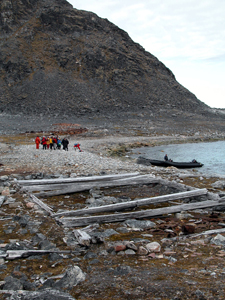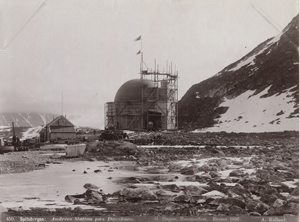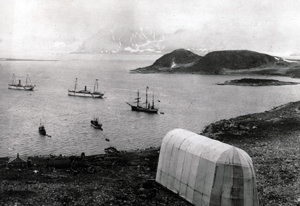"A secluded, eerie place ... A closed, unwelcoming bay" . This is how Fridtjof Nansen described Virgohamna in 1912 . And the scenery is indeed isolated and grey, but what it lacks in the way of beauty, it makes up for in other ways. Virgohamna is one of Svalbard's most important cultural heritage sites. On the beach are remains of blubber ovens and a Dutch whaling station. There are also graves from the whaling period. But Virgohamna is most famous for being the starting place of many an expedition attempting to reach the North Pole. Both Andrée (1896, 1897) and Wellman (1906, 1907, 1909) built bases here, consisting of a balloon shed, airship hangars and gas production works. The place was named after Andrée's steamship and transport vessel, the Virgo. All the areas with cultural remains in Virgohamna are protected. To disembark here, one must have written permission from the Governor of Svalbard.

Visitors on the beach by the remains of Wellman's base in Virgohamna. His gas production works can be identified as a brown patch on the right. By the mountain in the background is where Andrée built the shed for his hot air ballon, Örnen (the Eagle). (Image: Nalan Koç / The Norwegian Polar Institute)
 The remains of Pike's house. (Image: Nalan Koç / The Norwegian Polar Institute)
The remains of Pike's house. (Image: Nalan Koç / The Norwegian Polar Institute)
 Andrée's balloon shed and Pike's house to the left. (Image: The Norwegian Polar Institute Photo Library)
Andrée's balloon shed and Pike's house to the left. (Image: The Norwegian Polar Institute Photo Library)
 View from Virgohamna with Wellman's airship hangar in the foreground – a covered steel skeleton. To the left Wellman's house can be seen. Expedition vessels and tourist ships lay anchored up. To the far right the Fridtjov of Tromsø can be seen, chartered by Wellman as an expedition vessel. (Image: The Norwegian Polar Institute Photo Library)
View from Virgohamna with Wellman's airship hangar in the foreground – a covered steel skeleton. To the left Wellman's house can be seen. Expedition vessels and tourist ships lay anchored up. To the far right the Fridtjov of Tromsø can be seen, chartered by Wellman as an expedition vessel. (Image: The Norwegian Polar Institute Photo Library)
 Gas tanks which belong to Wallman's wrecked airship, the America. (Image: Kristin Prestvold / The Governor of Svalbard)
Gas tanks which belong to Wallman's wrecked airship, the America. (Image: Kristin Prestvold / The Governor of Svalbard)
The oldest cultural treasures in Virgohamna are from a Dutch whaling station called Harlinger Kokerij. Historical sources establish that the station was established in 1636 in what was then called Houker Bay. A few years later, whales had practically disappeared from Svalbard's fjords and coastal areas and it became necessary to hunt them in the open sea. By 1671, Friedrich Martens described Harlinger Kokerij as being in decay. The floors of storage buildings and houses are covered with layers of thick ice. Barrels, anvil, blacksmith’s tools and other equipment have exploded with the force of the frost, and are poking out of the ice.
The remains of the houses that Martens described are still visible in Virgohamna, as are the foundations of three double blubber ovens on the rocky beach. Ramps on the side of the ovens facilitated transport to and from the cooking vessels.
In 1888, Englishman Arnold Pike erected a pre-fabricated house on the remains of old Harlinger Kokerij. His intention was to spend the winter in Svalbard, with the aim of experiencing the changing seasons in this remote, exotic land. The original plan was to alight in Storfjorden, but ice conditions led to Pike’s party settling in Virgohamna. The house he built was later used by both Andrée and Wellman, and as late as 1920-21 it was used by the hunters Arthur Oxaas and Georg Nilsen. The house was torn down and moved to Barentsburg in 1925; its later fate is unknown.
In the summer of 1896 Swedish engineer Salomon August Andrée established a balloon base in Virgohamna with the intent of reaching the North Pole in the hot air balloon Örnen. As well as a balloon shed and house for him to live in, he also built a gas production works to make hydrogen gas to fuel the balloon. The weather was not kind in the season of 1896, and the voyage to the North Pole cancelled. Andrée returned the following year for a second attempt. In spite of dodgy weather conditions, the balloon took off from Virgohamna in 1897, with Frænkel, Strindberg and Andrée on board. The event was watched by the whole world, and several cruise ships had anchored up in the fjord outside of the island of Danskøya to observe the happenings. The balloon started its journey northwards and soon disappeared behind glaciers and mountains in the north-west corner of Spitsbergen. Nobody was to know any more of the expedition and its ending until 33 years later, when the remains of the expedition and its participants were found on the island of Kvitøya.
A few years after Andrée's departure new activity took place in the bay, this time as Walter Wellman prepared for his bid for the North Pole in an airship. He built an airship hangar, house and gas production works. Wellman made three failed attempts at reaching the North Pole: in 1906, 1907 and 1909. Wellman and his crew pioneered airship technology and constructed solutions which were well ahead of their time. But in 1906 the new technology completely failed, and they could but abandon the attempt. In 1907 the airship took off as expected, but it descended onto the glacier Smeerenburgbreen soon after. In 1909 events went as follows: the America rose and floated optimistically northwards, as Örnen had done 12 years before – over Hollenderneset and Fuglesongen and over the fast ice, which lay firm in Norskøysundet. But then the towing rope detached itself and fell in a heap onto the ice below. The wind gained strength and after a while the airship itself ended up on the ice too.
Captain Gunnar Isachsen happened to be in the area with the marine vessel Farm, and came to the rescue. The airship was taken back to Camp Wellman. To make it take off so that it could be towed into the hangar, the fuel tanks were punctured. When the balloon had been dragged onto dry land and was tipped over, the fuel flowed forwards, and the balloon skidded, broke free and hovered in the air. The gondola came loose and crashed onto the ground. The balloon went higher and higher until it exploded with a massive bang and fell into the water. Wellman took a bow and waved his hat, before he went to get a bottle of champagne and sat down to play solitaire. After a while he ordered the hangar to be lengthened by 11 m (Rossnes, 1993: 119). There was no new go for Wellman from Vigohamna on Danskøya.
Andrée and his expedition left many visible traces in Virgohamna. Bits of the balloon shed and gas works remain in the form of nails, bolts, wires, wood, wire fasteners, piles of rusty iron filings and lots more. To the far west of the bay, remains of Wellman's base can be found, such as the large hangar he built for the America, houses, boxes and barrels filled with iron filings for the hydrogren works, rusty petrol drums, iron scrap of all shapes and sizes, tools, equipment and other materials. The traces are very visible in the landscape, but as early as 1912, when Nansen visited Virgohamna, the place was described as being in decay. "The balloon shed had given in to the wind, after greedy hunters had helped themselves to steel and other useful materials. All sorts of things lay strewn between the rocks: several petrol drums made of iron, boxes, tools, cans, steel ropes twisted in all directions, acid-balloons, barrels with iron fillings, tie bolts etc. The works for the development of the hydrogen gas were still there. Most of the useful things, especially metal, had been stolen, although much of it remained: the hunters and the tourists had not yet got round to taking everything" (Nansen 1920: 149-150).
Traffic regulations
The cultural heritage of Virgohamna is significant, vulnerable and worn from traffic. The blubber ovens became popular photographic points and so were worn over time, and small artefacts are and were interesting travel souvenirs. The wooden remains of Wellman's collapsed hangar were walked upon, as were the remains of the airship America. The piles of iron filings around the hydrogen works were trampled to a mush. This is why from 2000 onwards regulations on traffic have been put into effect in Virgohamna. Anyone wishing to alight here must apply for permission from the Governor of Svalbard, who will be strict in granting it. The criteria for landing here are listed in a folder which can be obtained from the Governor of Svalbard.
The regulations control who alights and sets conditions on the visit. The information booklet Virgohamna – through the air towards the North Pole speaks of the sites cultural remains and history, and gives an outline of where visitors may go and where access is restricted. A map which shows where it is allowed to go in the area can be obtained from the Governor of Svalbard.